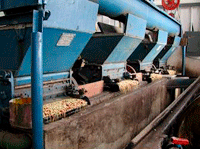

Dry-Process: The dry-process (also known as the natural method) produces coffee that is heavy in body, sweet, smooth, and complex. The dry-process is often used in countries where rainfall is scarce and long periods of sunshine are available to dry the coffee properly. Most coffees from Indonesia, Ethiopia, Brazil, and Yemen are dry-processed.
Wet-Process: Wet-processing coffees is a relatively new method of removing the four layers surrounding the coffee bean. This process results in a coffee that is cleaner, brighter, and fruitier. Most countries with coffee valued for its perceived acidity, will process their coffee using the wet-process.
Pulped Natural: The pulped natural method consists of pulping a coffee, but emitting the fermentation stage to remove the silverskin. This results in a beverage that has characteristics of both a dry- and wet-processed coffee. It is often sweeter than wet-processed coffees, has some of the body of a dry-processed coffee, but also retains some of the acidity of a wet-processed coffee. This type of processing can only occur in countries where the humidity is low and the coffee covered in the sweet mucilage can be dried rapidly without fermenting. Brazil has made this method famous and produces some of the best pulped natural coffees in the world. All twenty winners of the Gourmet Cup competition in Brazil in 2000 processed their coffees using the pulped natural method.
Re-passed: There is another type of coffee that has emerged on the market called re-passed or raisins. These coffees are floaters and are usually discarded with the rest of the floaters. However, they have a flavor profile that some of the world's best experts find to be much sweeter than traditional pulped coffees. The cherries float because they have dried too long on the tree before being collected. This, however, allows the bean to interact with the mucilage for a longer amount of time before the start of fermentation. The beans are removed from the rest of the floaters using a barrel system developed by Eduardo Sampio in Brazil. The coffees are then re-passed and pulped. They can then be washed or used as pulped naturals. The availability of the curiously sweet re-passed coffees is very limited since it is mainly experimental at this time. Ask your Brazilian supplier if they separate out this type of coffee and what flavor characteristics this coffee possesses. It may be another option for espresso blending and is likely to become the fourth category of coffee processing.
Information and Image Source: Coffee Research
Drying Process | Sorting | Polishing and Aging | Decaffeination Processes | Cupping | Roasting | Home Roasting


















































